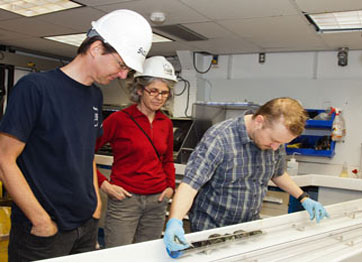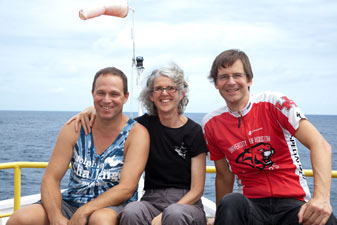

A University of Houston (UH) geoscientist and his colleagues are revealing new discoveries
about the Earth’s development, following a major international expedition that recovered
the first-ever drill core from the lower crust of the Pacific Ocean.
Co-chief scientists Jonathan Snow from UH and Kathryn Gillis from University of Victoria
in Canada led a team of 30 researchers from around the world on the $10 million expedition,
finding a few surprises upon penetrating the lower crust of the Pacific. Their findings
are described in the Dec. 1 issue of Nature in a paper titled “Primitive Layered Gabbros
from Fast-Spreading Lower Oceanic Crust.”
“The ocean crust makes up two-thirds of the Earth’s surface and forms from volcanic
magma at mid-ocean ridge spreading centers,” Snow said. “The deepest levels of this
process are hidden from view due to the miles of upper volcanic crust on top. So,
until now we had to make educated guesses about the formation of the lower crust based
on seismic evidence and the study of analogous rocks found on land.”
Traveling aboard the Integrated Ocean Drilling Program Expedition 345 to the Hess
Deep in the Pacific Ocean, the scientific voyagers recovered core sections of lower
crustal rocks, called gabbros, that formed more than two miles beneath the sea floor.
A large rift valley in the eastern equatorial Pacific, the Hess Deep is like an onion
sliced and pulled apart, revealing its deeper layers.
“Hess Deep is like a window into the lower crust of the ocean, where we can drill
directly into these lower crustal levels,” Snow said. “This is where magma rising
up from the Earth’s mantle begins to crystallize on its way to eventual eruption at
the sea floor.”
The two-month expedition, aboard the drilling vessel JOIDES Resolution, confirmed
for the first time the widespread existence of layered gabbros in the lower crust.
This observation had been predicted by plate tectonic theory and analogies made to
fragments of ocean crust found on land, called ophiolites, but only rarely had actual
layered rocks been recovered from the ocean floor.
A second surprise discovered by the explorers was akin to “finding gold in a silver
mine,” according to Snow. By studying thin slices of the gabbros under polarizing
microscopes, the scientists identified substantial amounts of the mineral orthopyroxene,
a magnesium silicate that was thought to be absent from the lower crust.
“Orthopyroxene by itself is nothing special. Traces of it are often found at late
stages of crystallization higher in the crust, but we never in our wildest dreams
expected a lot of it in the lower crust,” Snow said. “Although this mineral is not
economically valuable, the discovery means that basic chemical reactions forming the
lower crust will now have to be re-studied.”
A third surprise, Snow says, casts doubt on one of the main theories of the construction
of the lower ocean crust. It involved the mineral olivine, also a magnesium silicate.
This mineral is known to grow in delicate crystals sometimes found in layered intrusions
on land, but never expected in the ocean crust. This is because the separation of
the tectonic plates was thought to deform the magma like play dough in a partially
molten state that would have broken them up. However, Snow says, the last word isn’t
written on this, because the researchers just cored a small section of the crust in
one place on this expedition. To know for sure, they will have to explore the lower
crust more, which will require drilling.
The fourth phase of ocean drilling, to be called the “International Ocean Discovery
Program,” was approved in late November by the National Science Board (NSB). The NSB
is the governing board of the National Science Foundation and is responsible for guiding
the pursuit of national policies for promoting research and education in science and
engineering.
The paper is now online at http://www.nature.com/nature/journal/vaop/ncurrent/full/nature12778.html.
###
About the University of Houston
The University of Houston is a Carnegie-designated Tier One public research university
recognized by The Princeton Review as one of the nation’s best colleges for undergraduate
education. UH serves the globally competitive Houston and Gulf Coast Region by providing
world-class faculty, experiential learning and strategic industry partnerships. Located
in the nation’s fourth-largest city, UH serves more than 39,500 students in the most
ethnically and culturally diverse region in the country. For more information about
UH, visit the university’s newsroom.
About the College of Natural Sciences and Mathematics
The UH College of Natural Sciences and Mathematics, with 193 ranked faculty and nearly
6,000 students, offers bachelor’s, master’s and doctoral degrees in the natural sciences,
computational sciences and mathematics. Faculty members in the departments of biology
and biochemistry, chemistry, computer science, earth and atmospheric sciences, mathematics
and physics conduct internationally recognized research in collaboration with industry,
Texas Medical Center institutions, NASA and others worldwide.
To receive UH science news via email, sign up for UH-SciNews.
For additional news alerts about UH, follow us on Facebook and Twitter.